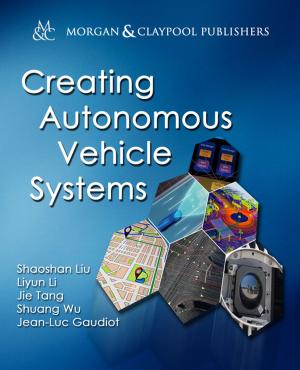Robot Learning from Human Teachers
Nonfiction, Computers, Advanced Computing, Theory, Artificial Intelligence, General Computing| Author: | Sonia Chernova, Andrea L. Thomaz | ISBN: | 9781681731797 |
| Publisher: | Morgan & Claypool Publishers | Publication: | April 1, 2014 |
| Imprint: | Morgan & Claypool Publishers | Language: | English |
| Author: | Sonia Chernova, Andrea L. Thomaz |
| ISBN: | 9781681731797 |
| Publisher: | Morgan & Claypool Publishers |
| Publication: | April 1, 2014 |
| Imprint: | Morgan & Claypool Publishers |
| Language: | English |
Learning from Demonstration (LfD) explores techniques for learning a task policy from examples provided by a human teacher. The field of LfD has grown into an extensive body of literature over the past 30 years, with a wide variety of approaches for encoding human demonstrations and modeling skills and tasks. Additionally, we have recently seen a focus on gathering data from non-expert human teachers (i.e., domain experts but not robotics experts). In this book, we provide an introduction to the field with a focus on the unique technical challenges associated with designing robots that learn from naive human teachers. We begin, in the introduction, with a unification of the various terminology seen in the literature as well as an outline of the design choices one has in designing an LfD system. Chapter 2 gives a brief survey of the psychology literature that provides insights from human social learning that are relevant to designing robotic social learners. Chapter 3 walks through an LfD interaction, surveying the design choices one makes and state of the art approaches in prior work. First, is the choice of input, how the human teacher interacts with the robot to provide demonstrations. Next, is the choice of modeling technique. Currently, there is a dichotomy in the field between approaches that model low-level motor skills and those that model high-level tasks composed of primitive actions. We devote a chapter to each of these. Chapter 7 is devoted to interactive and active learning approaches that allow the robot to refine an existing task model. And finally, Chapter 8 provides best practices for evaluation of LfD systems, with a focus on how to approach experiments with human subjects in this domain.
Learning from Demonstration (LfD) explores techniques for learning a task policy from examples provided by a human teacher. The field of LfD has grown into an extensive body of literature over the past 30 years, with a wide variety of approaches for encoding human demonstrations and modeling skills and tasks. Additionally, we have recently seen a focus on gathering data from non-expert human teachers (i.e., domain experts but not robotics experts). In this book, we provide an introduction to the field with a focus on the unique technical challenges associated with designing robots that learn from naive human teachers. We begin, in the introduction, with a unification of the various terminology seen in the literature as well as an outline of the design choices one has in designing an LfD system. Chapter 2 gives a brief survey of the psychology literature that provides insights from human social learning that are relevant to designing robotic social learners. Chapter 3 walks through an LfD interaction, surveying the design choices one makes and state of the art approaches in prior work. First, is the choice of input, how the human teacher interacts with the robot to provide demonstrations. Next, is the choice of modeling technique. Currently, there is a dichotomy in the field between approaches that model low-level motor skills and those that model high-level tasks composed of primitive actions. We devote a chapter to each of these. Chapter 7 is devoted to interactive and active learning approaches that allow the robot to refine an existing task model. And finally, Chapter 8 provides best practices for evaluation of LfD systems, with a focus on how to approach experiments with human subjects in this domain.















